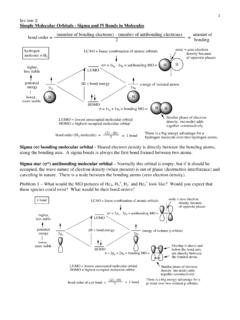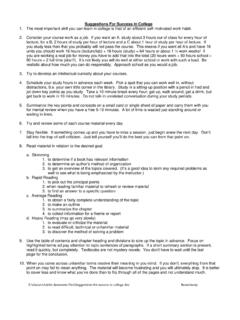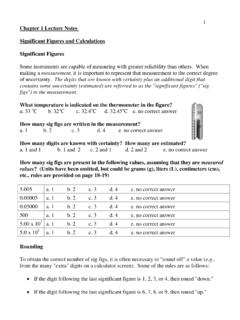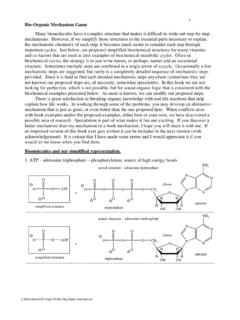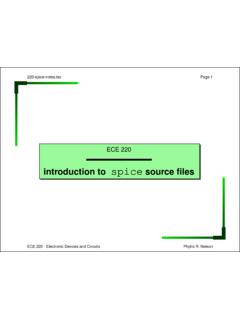Transcription of Chem 201/Beauchamp Topic 1: …
1 Chem 201/Beauchamp Topic 1: Atoms, bonding , dipoles ,IP 1 Atomic Structure Since molecules are constructed from atoms, we will quickly review the structure of atoms. Volume of electron cloud compared to volume of nucleusVeVn4 3( )( )(100,000)3 = 4 x 1015==electron clouds determine the overall volumeof atomsmass protonsmass electrons18001protons and neutronsdetermine an atom's mass=ecoreevalencep,n1100,000p = protons = constant # that defines the elementn = neutrons = varies = defines the isotopee = electrons = varies, depending on bonding patterns associated termif electrons = protons (same # of e's and p's) atomif electrons < protons (deficiency of e's) cationif electrons > protons (excess of e's) anion(eval)
2 = valence electrons = The outermost layer of electrons, which determines the bonding patterns. The usual goal is to attain a noble gas configuration. This is accomplished by losing e's (forming cations) or gaining e's (forming anions) or sharing e's (covalent bonds)(ecore) = core electrons = The innermost layer(s) of electrons (usually full shells or subshells). These e's are held too tightly for bonding (sharing) and not usually considered in the bonding picture. These e's cancel a portion of the nuclear charge (called shielding) so that the valence e's only see part of the nuclear charge, called = (# protons) - (core e's) = the effective nuclear charge.
3 This is the net positive charge felt by the valence e's ( bonding and lone pairs). Zeffective = same # as the column of the main group What if you were the nucleus of an atom? Let s assume you are 5 feet tall and weigh 100 pounds. The diameter of the electron cloud would be approximately 500,000 feet. Since there are about 5,000 feet in a mile the diameter would be about 100 miles (approximately the distance to San Diego). The volume would be (4/3)( )r3, or about 500,000 miles3. Amazingly, the entire electron cloud would only have a mass of (1/1800)x100 pounds 1 ounce! 5 feet = dr = feetvolume = (4/3)( )(r)3 67 ft3 100 lbs.
4 = 1600 = (100,000) x (5 feet) = 500,000 feet 100 milesr = 50 milesvolume = (4/3)( )(r)3 500,000 miles3mass 1 ounceIf you were thenucleuselectroncloud Chem 201/Beauchamp Topic 1: Atoms, bonding , dipoles ,IP 2 Effective nuclear charge - Zeffective is the net positive charge felt by the valence electrons ( bonding and lone pair electrons). It can be estimated by subtracting the number of core electrons from the total nuclear charge. =approximate positive charge felt by the valence electronsZeffective = (Ztotal) - (# core electrons) Zeffective is an important parameter in determining how tightly an atom pulls electrons to itself and in determining the polarity of its bonds. Polarity is one of our more important concepts.
5 Problem 1 What is the total nuclear charge and effective nuclear charge for each of the atoms below? How does this affect the electron attracting ability of an atom? Ztotalcore electrons=H Li Na K B Al C Si N P O S F Cl Br I He Ne ArZeffective== Problem 2 - Which atom in each pair below probably requires more energy to steal away an electron (also called ionization potential IP)? Why? Are any of the comparisons ambiguous? Why? Check your answers with the data in the table on page 8. a. C vs N b. N vs O c. O vs F d. F vs Ne Atomic Orbital - a region in space about an atom where there is a high probability of finding up to two electrons (2 e-).
6 The shape of an orbital is predicted by the mathematics of quantum mechanics (we just need to know what the pictures look like). Where the electrons are is where the bonds will be. The bonds give rise to the shape and polarity of the molecule which in turn affects the chemistry we observe and study. What do atomic orbitals look like? a. s orbitals are spherical in shape. The wave nature of electrons (phase) may change as the distance increases from the nucleus but at any fixed distance from the nucleus the phase nature of s electrons will be the same (think of layers on an onion). Nodes are regions in space where the probability of finding an electron is zero (the phase is zero). b. p orbitals have a dumbbell shape with two lobes at 180o to one another with opposite phase nature.
7 All p lobes intersect at the nucleus with zero probability of finding any electron density (= node). a single 2p orbital,has node at nucleusall three 2p orbitals (2px, 2py, 2pz)are oriented at 90o to one another,represented as px, py and Chem 201/Beauchamp Topic 1: Atoms, bonding , dipoles ,IP 3 c. d and f orbitals have more complicated shapes and are not important to beginning organic chemistry. However they are important for understanding the inorganic world and many biochemical molecules involve the chemistry of d orbitals (like iron in hemoglobin, cobalt in vitamin b12, and zinc, copper, manganese and others in proteins.). We will not discuss these in our course. lobes in the yz plane lobes in the xz plane lobes in the xy plane lobes in the xy planealong axeslobes along the z axisxyzdyzdxzdxydx2-y2dz2xxxxyyyyzzzzWe rarely have occasion to discuss d orbitals.
8 They are helpful in discussions of sulfur, phosphorous and a few transition metals. Even in those discussions you canmainly look at them as biggerversions of p-like orbitals. Part of the rest of the periodic table is shown below. Many of these elements are used in organic chemistry and biochemistry. We will use some of these in our discussions, though often only briefly. H LiNa K RbCsBeMgCaSrBaScYLaTiZrHfVNbTaCrMoWFeRuO sCoRhIrNiPdPtZnCdHgBAlGaInTlCSiGeSnPbNPA sSbBiOSSeTePoFClBrIAt1A2A3B 4B5B6B8B1 BMnTcRe2B3A 4A5A 6A 7A7B8 ACuAgAuHeNeArKrXeRnUsually = +1+2-2-10???Transition elements tend to have severaloxidation states, mostly on the left side and in the middle tend to lose electrons forming cations, while elements on the right side tend to gain electrons forming anions or to share electrons forming covalent , in the middle right, usually shares electrons in covalent bonds (single, double and triple).
9 A Noble gasconfiguration is the goal of most atoms. Bonds represent an overlap of orbitals, which are a region where negative electron density is present. Electrons allow positive nuclei to remain in close proximity (come together). In our course covalent bonds will represent two shared electrons between two bonded atoms. We propose two types of covalent bonds: sigma, where electron density is directly between the two bonded atoms and pi, where electron density is above and below (or in front and in back) of a line connecting the two bonded atoms. Sigma bonds are always the first bond and pi bonds are the second (and third) bonds overlapping a sigma bond. Pi bonds are represented by sideways overlap of two p orbitals. possible sigma bonds - the electron density is directly between the two bonded atoms, always the first bondABAHpi bonds - the electron density is above and below the two bonded atoms(or in front and in back), none is directly between, always second or third bondsAB bond bond bond Atomic Configuration provides a representation of the electrons about a single isolated atom.
10 Atoms represented are NOT in molecules. The usual atomic orbitals (s,p,d,f) are used and electrons fill into these atomic orbitals according to a few simple rules. The electrons closest to the nucleus are held the tightest and called the core electrons (full shells), while those in the incompletely filled outermost shell are called valence electrons. The valence electrons largely determine the bonding patterns and chemistry of the atom in order to gain a Noble gas configuration. Chem 201/Beauchamp Topic 1: Atoms, bonding , dipoles ,IP 4 +znucleus1s2s2p2p2p3s3p3p3p3d3d3d3d3dn=1 shelln=2 shelln=3 shellElectrons fill into atomic orbitals according tothe following Pauli Exclusion Principle - only two electrons may occupy any orbital and those electrons must have opposite spins2.
